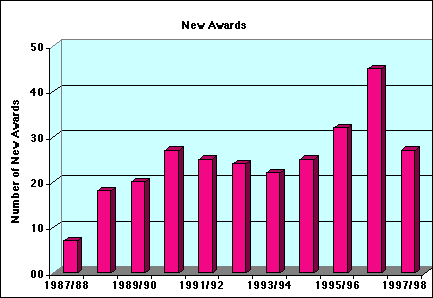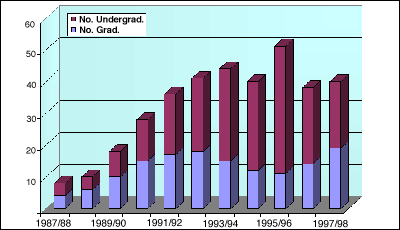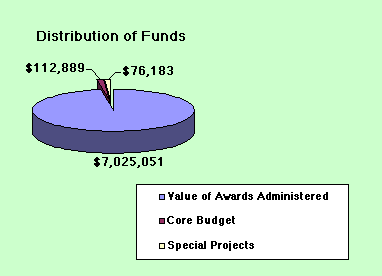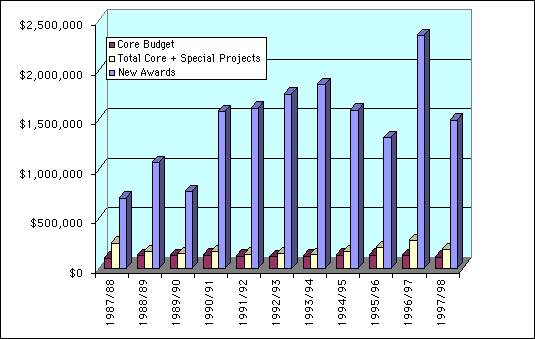Director's Statement
Goals:
The goals of the ICS are based on an increased understanding of the formation of and processes within the crust and lithosphere of the earth by utilizing the approaches of many disciplines and the expertise of scientists in academia, government and industry.
Current Mission:
The current mission of the ICS is to provide the research leadership, organizational structure and facilities to promote the cooperation of scientists from various research groups and organizations to study processes that occur within the earth and in particular, the earth's crust. The research agenda of the ICS comprises the study of crustal structure, tectonics, earthquakes, crustal materials, and pollution/contamination from natural and man-made processes.
Contribution to the Instructional and Research Mission of the Campus:
As will become evident in this annual report the Institute’s activities span the spectrum of the UCSB’s commitment to education and research. During the past year 39 faculty, professional researchers and postdoctoral researchers together with 19 graduate students and 21 undergraduates have steadily pursued their research goals within the ICS. The researchers submitted 27 successful proposals at a success rate of 41% for a total value of $1,497,407. A comparison of the number of new awards with previous years is illustrated in Figure 1. In return these individuals have contributed 36 papers and reports, given more than 15 presentations at professional meetings, seminars and workshops, and actively supported their various professions as members of boards, panels, committees and reviewers of papers and proposals. Particular research accomplishments and individuals are described later. ICS has been broadening its scope of research through multidisciplinary activities such as the investigation of the natural hydrocarbon seeps right off the coast of Santa Barbara. This study involves four investigators and several graduate students from Departments of Geological Sciences and Geography. The characterization and role of friction in dynamics of earthquake ruptures is the basis of a collaborative research effort between the Materials Research Laboratory and ICS. Similarly, ICS researchers have made available the facilities of the Vadose Zone Laboratory to graduate students and faculty in the Bren School of Environmental Science and Management.

Figure 1: The number of new awards is shown for each year since ICS was established. The decrease in 1997/98 is an artifact of the timing of the major Southern California Earthquake Center award. Eight awards totaling $542,0000, that normally are part of our annual package, arrived a couple of weeks after the June 30 deadline.
While ICS, like other ORU’s on campus, has a primary mission of research, it is obvious that education is an integrated element. As discussed in more detail later, both graduates and undergraduates have been and continue to be fully immersed in the research activities at ICS (Figure 2). There is almost a one-to-one ratio of principal investigators and students. The student contribution is noticeable in the number of presentations given at symposia and professional meetings including undergraduates who are co-authors on several of the reports, papers and abstracts of talks presented at national meetings. Gretchen Mullendore, an undergraduate who started doing independent research as a Southern California Earthquake Center (SCEC) intern at ICS in 1996 and continued through her graduation, was given the Charles Douglas Woodhouse Award as the outstanding graduating senior in the Department of Geological Sciences (DGS) who is most likely to succeed as a professional. Mullendore also received a Coast Geological Society Scholarship. David Oglesby, a PhD graduate student studying the rupture dynamics of dipping faults, received the Geological Sciences Wendell Phillips Woodring Memorial Graduate Fellowship as a "student who is working on a thesis proposal of highest merit and who is judged capable of seeing it to a distinguished and early conclusion." Oglesby was also awarded the G.K. Gilbert Award for the graduate student in the DGS who has presented the best paper based on original research at a Departmental Journal Club talk. Many of the professional research staff serve as thesis committee members for the graduate students. They also teach or assist in the teaching of classes on campus. Dr. Craig Nicholson taught two upper division courses, Seismology and Reflection Seismology & Subsurface Imaging, The undergraduate Physical Geology course and honors section were taught by Dr. Wendy Bohrson, and Dr. Jeff Lee taught an upper division course in Environmental Geology. Nicholson was named adjunct professor in the DGS. Education is a two-way street at ICS with the students directly involved in research and the professional researchers directly involved in teaching.

Figure 2: The total number of students involved in ICS research activities are plotted for each year. Over the past several years the number of students has been between 30 and 40, roughly comparable to the number of faculty and professional researchers in ICS. This year there are 19 graduates and 21 undergraduates.
During the past year ICS has been host to 26 visitors, seven of whom spent from a month to a year collaborating with researchers at ICS. Six of these seven individuals were from foreign countries with fresh perspectives on many of the problems being studied. Their presence enriched and enlivened the research environment at ICS as well as the campus. Dr. Igor Zektser, Water Problems Research Institute, Russian Academy of Sciences, used a Fulbright Fellowship to collaborate with Dr. Lorne Everett to finalize the first world groundwater map–a 5-year project. Professor Raul Madariaga, Ecole Normale, working with Drs. Kim Olsen and Ralph Archuleta produced a dynamic simulation of the 1992 Landers M7.3 earthquake. Dr. Paul Spudich, U. S. Geological Survey, together with Archuleta, Olsen and Eleanore Jewel, a new graduate student, laid the groundwork for a successful proposal on earthquake simulations in the San Francisco Bay area. In addition to the visitors, ICS has been home to postdoctoral fellows Stefan Nielsen (Naples) supported by Materials Research Laboratory and Peng-Cheng Liu (Beijing) supported by SCEC. While these visitors and postdoctoral fellows provide a direct link to new ideas, they also leave an intangible impression on the students who can see first hand that much of the research has an impact well beyond the confines of UCSB.
We do not have to travel the world though to make an impression. With ICS researchers studying, for example, the cause and effects of natural oil seeps off the Santa Barbara coast; the contamination and bioremediation of leaking underground fuel tanks; or the ever present threat of earthquakes, there is always an undercurrent of interest on a local, national and sometimes international level. For example, Archuleta was invited to present a talk on anticipating the next big earthquake in southern California at the International Symposium on Natural Disaster Prediction and Mitigation, in Kyoto, Japan. Everett was invited to attend the World Laboratory meeting in Geneva, Switzerland, to identify groundwater monitoring and remediation strategies for countries in Eastern Europe, Russia and China. Olsen’s simulations of ground motion from large earthquakes in southern California were featured on the Discovery Channel. The Los Angeles Times highlighted the results of Olsen and Carmen Alex, an undergraduate, on a possible explanation for the anomalous damage in Santa Monica during the 1994 Northridge earthquake.
In the past year, there have been significant changes in the administration of ICS. After 10 years of skillful stewardship, Prof. Bruce Luyendyk stepped down from the Director’s helm and passed it onto Archuleta as Acting Director. (Luyendyk became chair of the Department of Geological Sciences and still serves on the ICS Advisory Committee as well as being an active principal investigator in ICS. ) There is an active search for a Director of ICS; the professorship will reside in the DGS. The research emphasis for this position is in tectonic geodesy with a research interest in quantitative crustal deformation. Prof. Art Sylvester assumed the duties of Associate Director formerly held by Archuleta. Almost coincident with the change in Director was a critical change in the MSO. Kathy Murray filled the MSO vacancy created by the departure of Maureen Evans, now MSO of the Materials Research Laboratory. Fortunately, this transition period has been relatively smooth because both Murray and Archuleta have been long-time members of ICS and because of the support and encouragement by all of ICS.
ICS continues to operate with a minimal staff (2.0 permanent FTE, 0.5 casual FTE). This administrative staff supports 39 principal investigators and 40 students (graduate and undergraduate) on 62 research projects from 19 different agencies. The total award value administered has grown to over $7 M while the budgets for the core and special projects have remained low (Figure 3). Likewise, the amount of new awards has been increasing while the operational cost has remained nearly constant (Figure 4).

Figure 3: The total amount of awards being administered with the operational budget for administration and special projects at ICS.

Figure 4: The amount of new awards, the core budget and the core+special projects budget is shown for each year. As noted in the caption of Figure 1, had the SCEC funds arrived on time, the new awards for 1997/98 would have exceeded $2M. The operational costs have remained fairly ocnstant over time.
Home Page || E-mail